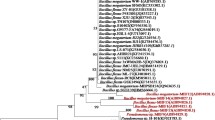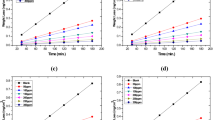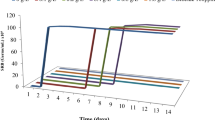Abstract
In the present investigation, biocorrosion inhibition efficiency of Syzygium aromaticum (clove) aqueous extract on carbon steel in presence of four corrosion causing bacterial strains (Bacillus subtilis, Streptomyces parvus, Pseudomonas stutzeri, and Acinetobacter baumannii) was explored. Weight loss, potentiodynamic polarization, and AC impedance studies were carried out with and without bacterial strains and clove extract. The results obtained from weight loss and AC impedance studies indicate that these corrosion causing bacterial strains accelerated the biocorrosion reaction and biofilm playing a key role in this process. However, the addition of clove extract into the corrosive medium decreased the corrosion current and increased the solution and charge transfer resistance. The significant inhibition efficiency of about 87% was archived in the mixed consortia system with clove extract. The bioactive compounds were playing an important role in the antibacterial activity of the clove extract. It was revealed that clove extract has both biocidal and corrosion inhibition properties.








Similar content being viewed by others
References
Javaherdashti R (2011) Impact of sulphate-reducing bacteria on the performance of engineering materials. Appl Microbiol Biotechnol 91:1507–1517
Kannan P, Su SS, Mannan MS, Castaneda H, Vaddiraju S (2018) A review of characterization and quantification tools for microbiologically influenced corrosion in the oil and gas industry: current and future trends. Ind Eng Chem Res 57:13895–13922
Wan H, Song D, Zhang D, Du C, Xu D, Liu Z, Ding D, Li X (2018) Corrosion effect of Bacillus cereus on X80 pipeline steel in a Beijing soil environment. Bioelectrochemistry 121:18–26
Jia R, Yang D, Xu D, Gu T (2018) Carbon steel biocorrosion at 80 °C by a thermophilic sulfate reducing archaeon biofilm provides evidence for its utilization of elemental iron as electron donor through extracellular electron transfer. Corros Sci 145:47–54
Rajasekar A, Babu TG, Pandian SK, Maruthamuthu S, Palaniswamy N, Rajendran A (2007) Biodegradation and corrosion behavior of manganese oxidizer Bacillus cereus ACE4 in diesel transporting pipeline. Corros Sci 49:2694–2710
Parthipan P, Narenkumar J, Elumalai P, Preethi PS, Nanthini AUR, Agrawal A, Rajasekar A (2017) Neem extract as a green inhibitor for microbiologically influenced corrosion of carbon steel API 5LX in a hypersaline environments. J Mol Liq 240:121–127
Kotu SP, Mannan MS, Jayaraman A (2019) Emerging molecular techniques for studying microbial community composition and function in microbiologically influenced corrosion. Int Biodeterior Biodegrad 144:104722
Elumalai P, AlSalhi MS, Mehariya S, Karthikeyan OP, Devanesan S, Parthipan P, Rajasekar A (2020) Bacterial community analysis of biofilm on API 5LX carbon steel in an oil reservoir environment. Bioprocess Biosyst Eng. https://doi.org/10.1007/s00449-020-02447-w
Tsarenko IV, Makarevich AV, Orekhov DA (1998) Microbicidal properties of polymer films modified by five-membered polynitrogen heterocycles. Bioprocess Eng 19(1998):469–473
Li E, Wu J, Zhang D, Sun Y, Chen J (2018) D-phenylalanine inhibits the corrosion of Q235 carbon steel caused by Desulfovibrio sp. Int Biodeterior Biodegrad 127:178–184
Liu H, Xu D, Dao AQ, Zhang G, Lv Y, Liu H (2015) Study of corrosion behavior and mechanism of carbon steel in the presence of Chlorella vulgaris. Corros Sci 101:84–93
Zhou E, Li H, Yang C, Wang J, Xu D, Zhang D, Gu T (2018) Accelerated corrosion of 2304 duplex stainless steel by marine Pseudomonas aeruginosa biofilm. Int Biodeterior Biodegrad 127:1–9
Zacheus OM, Lehtola MJ, Korhonen LK, Martikainen PJ (2001) Soft deposits, the key site for microbial growth in drinking water distribution networks. Water Res 35:1757–1765
Parthipan P, Elumalai P, Karthikeyan OP, Ting YP, Rajasekar A (2017) A review on biodegradation of hydrocarbon and their influence on corrosion of carbon steel with special reference to petroleum industry. J Environ Biotech Res 6:12–33
Liduino VS, Cravo-Laureau C, Noel C, Carbon A, Duran R, Lutterbach MT, Servulo EFC (2019) Comparison of flow regimes on biocorrosion of steel pipe weldments: community composition and diversity of biofilms. Int Biodeterior Biodegrad 143:104717
Liduino VS, Filho JCP, Cravo-Laureau C, Lutterbach MT, SErvulo EFC, (2019) Comparison of flow regimes on biocorrosion of steel pipe weldments: fluid characterization and pitting analysis. Int Biodeterior Biodegrad 144:104750
Ramalingam V, Dhinesh P, Sundaramahalingam S, Rajaram R (2019) Green fabrication of iron oxide nanoparticles using grey mangrove Avicennia marina for antibiofilm activity and in vitro toxicity. Surf Interf 15:70–77
Fish KE, Osborn AM, Boxall J (2016) Characterising and understanding the impact of microbial biofilms and the extracellular polymeric substance (EPS) matrix in drinking water distribution systems. Environ Sci Water Res Technol 2:614
Parthipan P, Babu TG, Anandkumar B, Rajasekar A (2017) Biocorrosion and its impact on carbon steel API 5LX by Bacillus subtilis A1 and Bacillus cereus A4 isolated from Indian crude oil reservoir. J Bio Tribo Corros 3:32
Xu D, Gu T (2015) The war against problematic biofilms in the oil and gas industry. J Microb Biochem Technol 7:124
Tator KB (2003) In hydrogen sulfide and microbiologically induced corrosion of concrete steel and ductile iron in waste water facilities. Corrosion. NACE International, Texas
Rajasekar A, Anandkumar B, Maruthamuthu S, Ting YP, Rahman PK (2010) Characterization of corrosive bacterial consortia isolated from petroleum product transporting pipelines. Appl Microbiol Biotechnol 85:1175–1188
Cetin D, Aksu ML (2009) Corrosion behavior of low-alloy steel in the presence of Desulfotomaculum sp. Corros Sci 51:1584–1588
Bsharat TK (1998) Detection, treatment, and prevention of microbiologically influenced corrosion in water-based fire protection systems. National Fire Sprinkler Association
Blanco M, Negro C, Gaspar I, Tijero J (1996) Slime problems in the paper and board industry. Appl Microbiol Biotechnol 46:203–208
Maruthamuthu S, Nagendran T, Anandkumar B, Karthikeyan M, Palaniswamy N, Narayanan G (2011) Microbiologically influenced corrosion on rail. Curr Sci 100:870–880
Flitton MKA, Yoder TS (2012) In twelve year study of underground corrosion of activated metals. Corrosion. NACE International, Texas
Jacobson GA (2007) Corrosion at Prudhoe Bay: a lesson on the line. Mater Perform 46(8):26–35
Ismail AS, Farag AA (2020) Experimental, theoretical and simulation studies of extracted crab waste protein as a green polymer inhibitor for carbon steel corrosion in 2 M H3PO4. Surf Interf 19:100483
Kaskah SE, Pfeiffer M, Klock H, Bergen H, Ehrenhaft G, Ferreira P, Gollnick J, Fischer CB (2017) Surface protection of low carbon steel with N-acyl sarcosine derivatives as green corrosion inhibitors. Surf Interf 9:70–78
Aktas DF, Sorrell KR, Duncan KE, Wawrik B, Callaghan AV, Suflita JM (2017) Anaerobic hydrocarbon biodegradation and biocorrosion of carbon steel in marine environments: the impact of different ultra low sulfur diesels and bioaugmentation. Int Biodeterior Biodegrad 118:45–56
Suarez EM, Lepkova L, Kinsella B, Machuca LL (2019) Aggressive corrosion of steel by a thermophilic microbial consortium in the presence and absence of sand. Int Biodeterior Biodegrad 137:137–146
Ali AI, Mahrous YS (2017) Corrosion inhibition of c-steel in acidic media from fruiting bodies of Melia azedarach L. extract and a synergistic Ni2+ additive. RSC Adv 7:23687
Gadow HS, Motawea MM (2017) Investigation of the corrosion inhibition of carbon steel in hydrochloric acid solution by using ginger roots extract. RSC Adv 7:24576
Wang O, Tan B, Bao H, Xie Y, Mou Y, Li P, Chen D, Shi Y, Li X, Yang W (2019) Evaluation of Ficus tikoua leaves extract as an eco-friendly corrosion inhibitor for carbon steel in HCl media. Bioelectrochemistry 128:49–55
Raghavendra N (2018) Areca plant extracts as a green corrosion inhibitor of carbon steel metal in 3 M hydrochloric acid: gasometric, colorimetry and atomic absorption spectroscopy views. J Mol Eng Mater 6:1850004
Bourazmi H, Tabyaoui M, Hattabi LE, Aoufir YE, Taleb M (2018) Methanolic extract of Salvia officinalis plant as a green inhibitor for the corrosion of carbon steel in 1 M HCl. J Mater Environ Sci 9:928–938
Abdallah M, Altass HM, Jahdaly BAA, Salem MM (2018) Some natural aqueous extracts of plants as green inhibitor for carbon steel corrosion in 0.5 M sulfuric acid. Green Chem Lett Rev 11:189–196
Deyab MA, Osman MM, Elkholy AE, Heakal FET (2017) Green approach towards corrosion inhibition of carbon steel in produced oilfield water using lemongrass extract. RSC Adv 7:45241
He T, Emori W, Zhang R, Okafor PC, Yang M, Cheng C (2019) Detailed characterization of Phellodendron chinense Schneid and its application in the corrosion inhibition of carbon steel in acidic media. Bioelectrochemistry 130:107332
Lekbach Y, Xu D, Abed SE, Dong Y, Liu D, Khan MS, Koraichi SI, Yang K (2018) Mitigation of microbiologically influenced corrosion of 304L stainless steel in the presence of Pseudomonas aeruginosa by Cistus ladanifer leaves extract. Int Biodeterior Biodegrad 133:159–169
Narenkumar J, Parthipan P, Nanthini AUR, Benelli G, Murugan K, Rajasekar A (2017) Ginger extract as green biocide to control microbial corrosion of mild steel. 3 Biotech 7:133
Bhola SM, Alabbas FM, Bhola R, Spear JR, Mishra B, Olson DL, Kakpovbia AE (2014) Neem extract as an inhibitor for biocorrosion influenced by sulfate reducing bacteria: a preliminary investigation. Eng Fail Anal 36:92–103
Swaroop BS, Victoria SN, Manivannan R (2016) Azadirachta indica leaves extract as inhibitor for microbial corrosion of copper by Arthrobacter sulfureus in neutral pH conditions—a remedy to blue green water problem. J Taiwan Inst Chem Eng 64:269–278
Parthipan P, Elumalai P, Narenkumar J, Machuca LL, Murugan K, Karthikeyan OP, Rajasekar A (2018) Allium sativum (garlic extract) as a green corrosion inhibitor with biocidal properties for the control of MIC in carbon steel and stainless steel in oilfield environments. Int Biodeterior Biodegrad 132:66–73
Djouahra-Fahem D, Angar Y, Gana LM, Khoukhi F, Kebbouche-Gana S (2019) A comprehensive study on crude methanolic extract of Daphne gnidium L. as effective corrosion inhibitors of mild steel induced by SRB consortium. J Bio Tribo Corros 5:18
Cortes-Rojas DF, Fernandes de Souza CR, Oliveira WP (2014) Clove (Syzygium aromaticum): a precious spice. Asian Pac J Trop Biomed 4:90–96
Yang YC, Lee SH (2003) Ovicidal and adulticidal effects of Eugenia caryophyllata bud and leaf oil compounds on Pediculus capitis. J Agri Food Chem 51:4884–4888
Parthipan P, Elumalai P, Ting YP, Rahman PKSM, Rajasekar A (2018) Characterization of hydrocarbon degrading bacteria isolated from Indian crude oil reservoir and their influence on biocorrosion of carbon steel API 5LX. Int Biodeterior Biodegrad 129:67–80
Rajasekar A, Xiao W, Sethuraman M, Parthipan P, Elumalai P (2017) Airborne microorganisms associated with corrosion of structural engineering materials. Environ Sci Pollut Res 24:8120–8136
Mohammed KAK, Abdulkadhim HM, Noori SI (2016) Chemical composition and anti-bacterial effects of clove (Syzygium aromaticum) flowers. Int J Curr Microbiol App Sci 5:483–489
Chowdhry BZ, Ryall JP, Dines TJ, Mendham AP (2015) Infrared and raman spectroscopy of eugenol, isoeugenol, and methyl eugenol: conformational analysis and vibrational assignments from density functional theory calculations of the anharmonic fundamentals. J Phys Chem A 119:11280–11292
Hemalatha R, Nivetha P, Mohanapriya C, Sharmila G, Muthukumaran C, Gopinath M (2016) Phytochemical composition, GC-MS analysis, in vitro antioxidant and antibacterial potential of clove flower bud (Eugenia caryophyllus) methanolic extract. J Food Sci Technol 53:1189–1198
Saxena A, Sharma A, Saxena D, Jain P (2012) Corrosion inhibition and adsorption behavior of clove oil on iron in acidic medium. E J Chem 9:2044–2051
Azzouyahar E, Abu-Obaid A, Hajji ME, Bazzi L, Belkhaouda M, Lamiri A, Salghi R, Jodeh S, Essahli M (2016) Plants extract as green corrosion inhibitors: the case of eugenol from clove. Der Pharm Chem 8:467–475
Lekbach Y, Li Z, Xu D, Abed SE, Dong Y, Liu D, Gu T, Koraichi SI, Yang K, Wang F (2019) Salvia officinalis extract mitigates the microbiologically influenced corrosion of 304L stainless steel by Pseudomonas aeruginosa biofilm. Bioelectrochemistry 128:193–203
Jia R, Yang D, Rahman HBA, Gu T (2017) Laboratory testing of enhanced biocide mitigation of an oilfield biofilm and its microbiologically influenced corrosion of carbon steel in the presence of oilfield chemicals. Int Biodeterior Biodegrad 125:116–124
Narenkumar J, Parthipan P, Madhavan J, Murugan K, Marpu SB, Suresh AK, Rajasekar A (2018) Bioengineered silver nanoparticles as potent anti-corrosive inhibitor for mild steel in cooling towers. Environ Sci Pollut Res 25:5412–5420
Parthipan P, Sabarinathan D, Angaiah S, Rajasekar A (2018) Glycolipid biosurfactant as an eco-friendly microbial inhibitor for the corrosion of carbon steel in vulnerable corrosive bacterial strains. J Mol Liq 261:473–479
Zhai X, Myamina M, Duan J, Hou B (2013) Microbial corrosion resistance of galvanized coatings with 4,5-dichloro-2-n-octyl-4-isothiazolin-3-one as a biocidal ingredient in electrolytes. Corro Sci 72:99–107
Rajasekar A, Babu TG, Pandian STK, Maruthamuthu S, Palaniswamy N, Rajendran A (2007) Role of Serratia marcescens ACE2 on diesel degradation and its influence on corrosion. J Ind Microbiol Biotechnol 34:589–598
Li H, Yang C, Zhou E, Yang C, Feng H, Jiang Z, Xu D, Gu T, Yang K (2017) Microbiologically influenced corrosion behavior of S32654 super austenitic stainless steel in the presence of marine Pseudomonas aeruginosa biofilm. J Mater Sci Technol 33:1596–1603
Li Y, Xu D, Chen C, Li X, Jia R, Zhang D, Sand W, Wang F, Gu T (2018) Anaerobic microbiologically influenced corrosion mechanisms interpreted using bioenergetics and bioelectrochemistry: a review. J Mater Sci Technol 34:1713–1718
Acknowledgments
Dr. P. Parthipan, gratefully acknowledges the Science and Engineering Research Board (SERB), Department of Science and Technology (DST), for providing research fellowship under National Postdoctoral Fellowship (PDF/2017/001134). Also, authors are grateful to the researchers supporting project number (RSP-2020/68), King Saud University, Riyadh, Saudi Arabia.
Author information
Authors and Affiliations
Corresponding authors
Ethics declarations
Conflict of interest
The authors declare no competing financial interest.
Additional information
Publisher's Note
Springer Nature remains neutral with regard to jurisdictional claims in published maps and institutional affiliations.
Rights and permissions
About this article
Cite this article
Parthipan, P., AlSalhi, M.S., Devanesan, S. et al. Evaluation of Syzygium aromaticum aqueous extract as an eco-friendly inhibitor for microbiologically influenced corrosion of carbon steel in oil reservoir environment. Bioprocess Biosyst Eng 44, 1441–1452 (2021). https://doi.org/10.1007/s00449-021-02524-8
Received:
Accepted:
Published:
Issue Date:
DOI: https://doi.org/10.1007/s00449-021-02524-8




